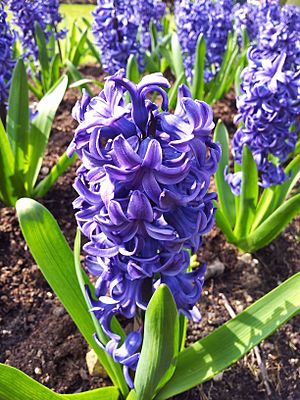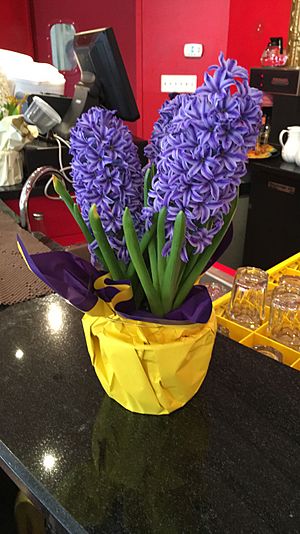Hyacinth (plant) facts for kids
Quick facts for kids Hyacinth (plant) |
|
|---|---|
 |
|
| Cultivar of Hyacinthus orientalis | |
| Scientific classification |
|
| Kingdom: | Plantae |
| Clade: | Tracheophytes |
| Clade: | Angiosperms |
| Clade: | Monocots |
| Order: | Asparagales |
| Family: | Asparagaceae |
| Subfamily: | Scilloideae |
| Genus: | Hyacinthus Tourn. ex L. |
| Species | |
Hyacinthus is a small group of plants that grow from bulbs. These plants bloom in spring and come back year after year. They are known for their lovely smell and are often just called hyacinths.
Hyacinths are originally from the eastern Mediterranean area. This includes places like northern Bulgaria all the way to northern Israel. Some other plants are also called "hyacinths," like Muscari (grape hyacinths). But these are different plants and not true hyacinths.
Contents
What Hyacinths Look Like
Hyacinths grow from a bulb, which is like a small onion. Each bulb usually grows about four to six long, narrow leaves. It also produces one to three tall stalks with many flowers.
In the wild, hyacinth flowers are usually spread out. Some types might have only two flowers on a stalk. Others, like the common hyacinth, have about six to eight flowers. Wild hyacinths grow to be about 15 to 20 centimeters (6 to 8 inches) tall. The hyacinths you see in gardens are often special types of H. orientalis. They have much fuller flower stalks and are usually stronger plants.
The Name and History of Hyacinths
The name Hyacinthus was first used by a scientist named Carl Linnaeus in 1753. It comes from an old Greek name for a plant, hyákinthos. This name is linked to a Greek myth about a young man named Hyacinthus. The story says that hyacinth flowers grew from his blood after he was accidentally killed by the god Zephyr.
Long ago, the word "hyacinth" was used for many different plants. Today, the Hyacinthus group is much smaller. It is now part of the Asparagaceae plant family.
Types of Hyacinths
There are three main types of plants in the Hyacinthus group:
- Hyacinthus litwinovii
- Hyacinthus orientalis – This is the common, or garden, hyacinth.
- Hyacinthus transcaspicus
Some scientists think that H. litwinovii and H. transcaspicus might belong to a different group called Hyacinthella. If that were true, then Hyacinthus would only have one type: H. orientalis.
Where Hyacinths Grow
Hyacinths are originally from the eastern Mediterranean region. This includes countries like Turkey, Turkmenistan, Iran, Iraq, Lebanon, Syria, and the Palestine area.
However, hyacinths are now grown in many other parts of the world. You can find them growing wild in places like Europe (including the Netherlands, France, and Italy), Korea, North America (the United States and Canada), and parts of Mexico, Cuba, and Haiti.
Growing Hyacinths in Gardens
The common garden hyacinth (H. orientalis) is very popular. It comes from southwest Asia. In the 1700s, people in the Netherlands loved hyacinths so much that they grew over 2,000 different kinds! The Netherlands is still a big producer of hyacinths today.
These garden hyacinths have a single, thick stalk of very fragrant flowers. They come in many colors, like red, blue, white, orange, pink, purple, or yellow. A smaller type, called the Roman hyacinth, has blue or white petals. These flowers like indirect sunlight and should be watered carefully.
Safety Tips for Hyacinths
It's important to know that hyacinth bulbs are poisonous. They contain a substance called oxalic acid. If you handle hyacinth bulbs, they might cause a mild skin irritation. It's a good idea to wear protective gloves when planting them.
Some plants that are sometimes called "hyacinths" are actually safe to eat. For example, the tassel hyacinth is used in cooking in some Mediterranean countries. But remember, true hyacinth bulbs are not safe to eat!
Hyacinths in Culture
Hyacinths are often seen as a symbol of spring and new beginnings. In Persian culture, the hyacinth flower is an important part of the Haft-Seen table. This table is set for Nowruz, the Persian New Year, which happens at the start of spring. The Persian word for hyacinth is sonbol.
The hyacinth also appears in a famous poem called The Waste Land by T. S. Eliot. In the poem, the narrator talks about a "hyacinth girl" and a "Hyacinth garden."
“You gave me hyacinths first a year ago;
“They called me the hyacinth girl.”
—Yet when we came back, late, from the Hyacinth garden,
Your arms full, and your hair wet, I could not
Speak, and my eyes failed, I was neither
Living nor dead, and I knew nothing,
Looking into the heart of light, the silence.
In some traditions, the hyacinth flower stands for being careful, staying true, wanting to go to heaven, and having a calm mind. This comes from the old story of Hyacinthus.
Gallery
-
Hyacinth cultivars in Floriade, Canberra
-
Hyacinth cultivars in Floriade, Canberra
-
White and purple hyacinth cultivars in Detroit, Michigan
Hyacinth Colors
The blue color of hyacinth flowers can be different shades. It can be a 'mid-blue', a violet blue, or a bluish purple. One specific shade is called Persenche. This is an American color name, probably from French, for a hyacinth blue.
The color Persenche is made up of about 73% ultramarine blue, 9% red, and 18% white.
See also
 In Spanish: Jacinto para niños
In Spanish: Jacinto para niños








